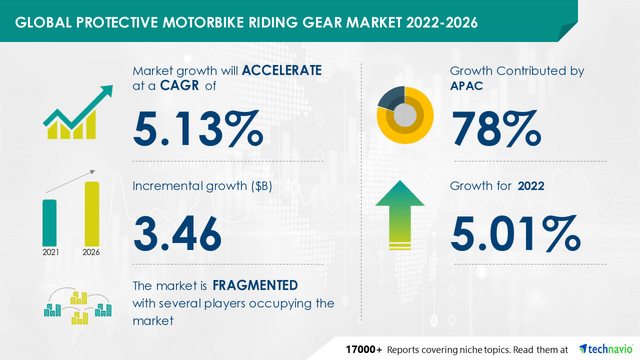[ad_1]
cemagraphics
Introduction
In October 2022, I wrote an article on SA about motorcycle safety gear company Leatt Corporation (OTCQB:LEAT) in which I said that it had no visible competitive advantage and that it seemed that the period of rapid growth could be coming to an end.
Well, revenues rose by just 5.2% to $23.3 million in Q3 2022 and sales of the flagship neck brace product were sluggish. In addition, the main reason that revenue growth stayed in positive territory was strong helmet sales. In my view, the coming months could be challenging for Leatt from a financial standpoint and I’m keeping my neutral rating. Let’s review.
Overview of the recent developments
In case you haven’t read any of my previous articles about Leatt, here’s a short description of the business. The company has the exclusive global manufacturing, distribution, sale, and use rights for an injection molded neck protection system for off-road moto riders named the Leatt-Brace. The first patents for this product were filed in 2003 and over 900,000 of these neck braces have been sold worldwide to date. However, I think the Leatt-Brace has lost its shine over the past years as it accounted for just 8% of revenues in Q3 2022. The majority of Leatt’s sales currently come from body armor and helmet products under its own brand. The company also offers knee braces, elbow guards, goggles, hydration bags and apparel items such as jerseys, pants, shorts and jackets. Leatt’s products are made mainly in China through outsource manufacturing arrangements. According to the past several quarterly financial reports, the company is building manufacturing capacity Thailand and Bangladesh (see page 14 here) but when construction will be finished is anyone’s guess at this point.
Leatt is among the main players in the global protective motorbike riding gear sector, but the market is fragmented and data from Technavio shows that the vast majority of growth until 2026 will come from the Asia-Pacific region. This could be an issue for Leatt as Europe and North America account for about 80% of its sales.
Leatt’s revenue growth was almost flat for several years before rising above 20% in 2017 and reaching almost 90% in 2021 and I think that the most likely explanation is that the company was somehow getting market share at the expense of some of its competitors. However, I think that the only product that sets the company apart from its competition is the Leatt-Brace which seems to be out of favor with riders lately and readers of my previous article commented that many customers consider the other products cheap and the quality to be inferior to competitors. In light of this, I find it unsurprising that revenue growth has slowed dramatically over the past two quarters. Looking at the Q3 financial results, we can see that revenues rose by just 5.2% year on year and the main reason growth was positive was strong motorbike and mountain bike helmets and off-road motorcycle boots sales. In addition, there was a 51% increase in the sales volume of technical apparel designed for off-road motorcycle and mountain biking use which boosted the revenues of the other products, parts and accessories segment. Leatt-Brace sales slumped by over 30% and there were comments under my previous article about Leatt that riders consider this product to be old tech.
The company said in its Q3 financial report that there was exceptional global demand for its redesigned helmet line-up for off-road motorcycle use. However, it mentioned during its Q3 earnings call that while there is strong demand for high-end bikes, stock levels for lower-end bikes were very high and there was less demand. In my view, this raises concerns about protective motorbike riding gear sales over the coming months.
Looking at the valuation, Leatt’s TTM P/E ratio stands at 7.65x as of the time of writing and the company said during its Q3 earnings call that margins are likely to improve in the near future thanks to softening shipping rates. However, I’m concerned that the P/B ratio stands at 2.8x at the moment. Looking at the balance sheet, Leatt has an asset-light business model, and the tangible book value was just $39.8 million as of September 2022.
Overall, the Q3 2022 results of Leatt were decent as its net income came in at $4.1 million but I’m concerned that the revenue growth is almost gone. In addition, 2023 is likely to be challenging for the entire consumer cyclical sector as several major economies could face a prolonged recession. I still don’t see a significant moat here and there aren’t any major catalysts for the share price on the horizon. In addition, Leatt is listed on the OTC and the trading volume rarely exceeds 5,000 shares and I think that it could be best for risk-averse investors to avoid this stock.
Investor takeaway
In my view, Leatt has a compelling level of profitability, but it seems that revenue growth is evaporating, and the coming months could be underwhelming from a financial point of view. Looking at the long term, the situation doesn’t look much better as sales of its Leatt-Brace have been shrinking and most of the growth in the global protective motorbike riding gear is expected to come from the Asia Pacific region. Overall, Leatt seems like a relatively cheap value stock based on the P/E ratio, but the trading volume is low and the outlook for the growth of its business seems grim at the moment. I think that risk-averse investors should avoid this stock.
Editor’s Note: This article discusses one or more securities that do not trade on a major U.S. exchange. Please be aware of the risks associated with these stocks.
[ad_2]
Image and article originally from seekingalpha.com. Read the original article here.


